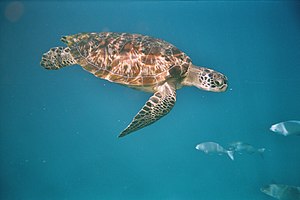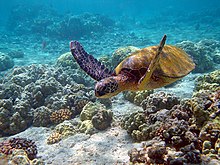Green sea turtle
| Green sea turtle | ||||||||||||
|---|---|---|---|---|---|---|---|---|---|---|---|---|

Green sea turtle ( Chelonia mydas ) |
||||||||||||
| Systematics | ||||||||||||
|
||||||||||||
| Scientific name of the genus | ||||||||||||
| Chelonia | ||||||||||||
| Brongniart , 1800 | ||||||||||||
| Scientific name of the species | ||||||||||||
| Chelonia mydas | ||||||||||||
| ( Linnaeus , 1758) |
The green sea turtle ( Chelonia mydas ) is a representative of the sea turtles and is one of the best-known species of this group. The black sea turtle , formerly known as the subspecies of Chelonia mydas , is now usually listed as a separate species, Chelonia agassizii . The name green sea turtle corresponds to the term "green turtle" which is common in English-speaking countries, but in Mexico, for example, the name "tortuga blanca" ("white sea turtle") is common. These names refer to the colors of the armor of the animals, the top of which is usually colored in different shades of brown with greenish or dark brown zones. The underside and the seams between the back panels are light yellow. The shell can reach a length of over a meter, the weight of the animal is a maximum of 185 kilograms.
It is also traditionally called green turtle because of its use as an ingredient in turtle soup .
Appearance
The green sea turtle reaches a carapace of up to 140 centimeters. The carapace is oval to heart-shaped and has four pairs of costal shields. The color of the carapace is olive to brown and usually has star-shaped pattern. The plastron, on the other hand, is pale yellow. The extremities and the head are brown. The scales on the head have a yellow border. The turtles have elongated claws on their front fins.
Adult females are larger than the males. The sexes can, however, be better differentiated by the fact that the carapace in the male is more pointed than in the female. As in most species of tortoise, the male's tail is significantly elongated.
Zoologists distinguish two to three subspecies.
Distribution and diet

Green sea turtles are found in all tropical and subtropical seas around the world, including the Mediterranean . The number of nesting beaches she uses is estimated at 44.
Important breeding areas are
- Rocas Atoll in the South Atlantic
- Laceped Islands on the coast of Northwest Australia
- Northwest Hawaii Islands
- Turkish and North Cyprus Mediterranean coasts
- Island Ascension in the South Atlantic
- The Turtle Islands , in the Sulu Sea . More than 1,000 nesting eggs are found on the archipelago every year. However, the number of nesting clutches seems to fluctuate very strongly. The number of nest eggs found was given as 14,220 in 2011 and over 1.44 million eggs. In 2004, the lowest number of nest sites was found so far, a little over 4,000.
10 other nesting beaches can be found on the Indian subcontinent.
The juveniles of the green sea turtle are carnivores that eat squids as well as the eggs of fish and sponges. Adult animals are mainly vegetarian and graze on the sea grass meadows.
Way of life
The turtle lives to be 40 to 50 years old and reaches sexual maturity between 10 and 15 years of age. The mating season is between October and February. Approximately 100 ping-pong-size eggs are laid per clutch. A female lays several clutches within a few weeks. The eggs take about two to three months to develop. The temperature during hatching determines the development of the sexes: While only males hatch at 28 ° C, only females hatch at 32 ° C. When the young hatch, they dig their own way out of the sand and rush into the sea. The green sea turtle usually lives solitary, with the exception of the egg-laying time.
The Green Turtle oriented because of their magnetic sense the Earth's magnetic field to years after hatching the first time to return to lay their eggs on the same beach. It is assumed that the inclination of the field lines of the magnetic field at the place of birth is permanently learned through imprinting .
Use and endangerment
Green sea turtles were hunted for a long time for their meat, and their eggs were also popular. Since they can survive long without food, they were used, for example, as living provisions for ships. The methods of slaughter were sometimes cruel: the animal was hung by the hind feet and the head was pulled out with a kind of tongs and severed. If you couldn't get to the head, a glowing iron was held on the armor so that the head was stuck out.
They were discovered as a delicacy by the British in the 18th century - the turtle soup soon became one of the most internationally sought-after haute cuisine dishes .
By the end of the 19th century, the hunt had reached such proportions that the green sea turtle was threatened with extinction. Since 1988 it has been under international protection through the Washington Convention on the Protection of Species . Animal rights activists and organizations strive for the survival of the species, including by guarding egg-laying beaches in Florida , on the Thai Similan Islands and on the beaches in Northern Cyprus, Turkey .
In Asia and the Caribbean, the green sea turtle is still considered a delicacy these days. A green sea turtle habitat in Malaysia is endangered by a natural gas power plant project and an iron and steel plant project.
As more female turtles than male turtles are born at elevated temperatures, global warming could be particularly fatal for turtle populations. There is already evidence of this for an Australian green turtle population, in which the ratio of 116 to 1 was found.
literature
- Indraneil Das: The turtles of the Indian subcontinent. Edition Chimaira, Frankfurt am Main 2001. ISBN 3-930612-35-6 .
Web links
- Photos of the green sea turtle. In: www.herp.it. Retrieved August 22, 2009 .
- Conservation efforts website (seaturtle.org)
- Sea Turtle Research and Conservation Project
- Chelonia mydas in the endangered Red List species the IUCN 2006. Posted by: Seminoff, 2004. Retrieved on 9 May, 2006.
- Chelonia mydas in The Reptile Database
Individual evidence
- ↑ Mark O'Shea et al. a .: Herpetological Diversity of Timor-Leste Updates and a Review of species distributions. In: Asian Herpetological Research. 2015, 6 (2): pp. 73-131., Accessed on July 17, 2015.
- ↑ honu in Hawaiian Dictionaries
- ↑ a b Das, p. 43
- ↑ Sonja Kastilan: Turtles in North Cyprus: Behind the fence on the beach . September 10, 2012.
- ↑ UNESCO: Turtle Islands Wildlife Sanctuary
- ↑ Philippines: Sea Turtle Baby Boom on Turtle Islands Breaks 28-year Record
- ↑ Das, p. 44
-
↑ Kenneth J. Lohmann, Catherine MF Lohmann, Llewellyn M. Ehrhart, Dean A. Bagley and Timothy Swing: Geomagnetic map used in sea turtle navigation. In: Nature. Volume 428, 2004, pp. 909-910, doi: 10.1038 / 428909a .
Turtles Use Earth's Magnetic Field As Map & Compasse. Published in The Independent , 2004. - ^ Gastronomic encyclopedia of fish, crabs and mussels, written by the editors of the "Zeitung der Köche" in 1898 Salzwasser Verlag (reprint), ISBN 978-3-86195-149-0 , section 17, page 147
- ↑ Archived copy ( memento of the original dated February 23, 2014 in the Internet Archive ) Info: The archive link was inserted automatically and has not yet been checked. Please check the original and archive link according to the instructions and then remove this notice.
- ↑ Greenpeace International (Ed.): Turtles under threat: Why the world's ultimate ocean wanderers need protection . January 2020 (English, greenpeace.at [PDF; 19.0 MB ; accessed on January 15, 2020]).

